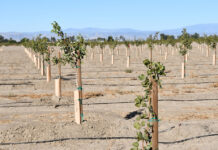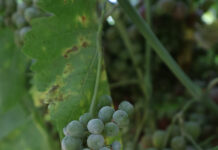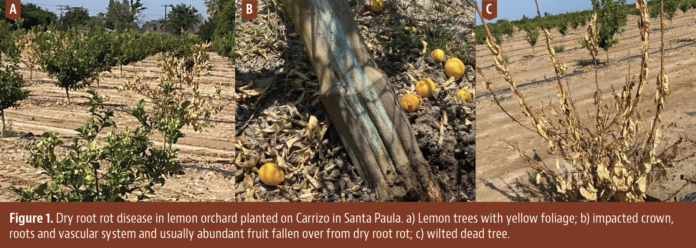
Dry root rot, caused by the soilborne fungus Fusarium solani, has been a persistent threat to California citrus for decades. While the disease has been preent in citrus orchards for many years, it became particularly problematic following wet winters in the 1960s and 1980s. During these periods, the disease affected both young and mature trees, especially those on susceptible rootstocks and in poorly drained soils. However, the threat of dry root rot persists today, posing an ongoing challenge to California’s citrus industry.
Fusarium solani
F. solani is a weak pathogen that requires a weakened host to cause significant damage. Factors like stress from other pathogens, nutrient deficiencies or environmental stressors can predispose citrus trees to infection. For example, Phytophthora root rot can weaken trees, making them more susceptible to F. solani attack. Trees planted as bare-root seedlings exhibited higher resistance to dry root rot compared to container-grown trees. However, fumigation prior to planting was associated with reduced disease incidence. Several factors can contribute to the development of dry root rot in citrus; a combination of environmental and host factors can predispose citrus trees to Fusarium solani infection. Periods of drought or excessive moisture can weaken trees, making them more susceptible to disease. High temperatures can exacerbate symptoms and promote fungal growth. Poor soil drainage and nutrient imbalances can further compromise tree health. Host factors also play a significant role. Certain rootstocks may exhibit greater susceptibility to F. solani infection compared to others. Older trees with declining vigor may be more prone to infection. The virulence of specific F. solani strains and the level of inoculum present in the soil can influence the severity of disease outbreaks. By understanding these complex interactions, growers can implement targeted management strategies to mitigate the impact of dry root rot on their citrus orchards.
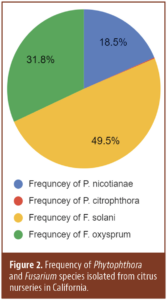
Finding the Cause
A comprehensive soil analysis was conducted to assess potential correlations between soil properties and disease incidence. Parameters, such as sodium, boron, salinity, pH and soil type, were evaluated. However, no significant correlations were found between these factors and disease severity. This suggests soil conditions, while important for overall tree health, may not be a primary factor in predisposing trees to dry root rot. Leaf tissue analysis revealed elevated levels of zinc and manganese in diseased trees compared to healthy trees. Additionally, potassium deficiency was observed in diseased trees. However, it is unlikely these nutrient imbalances are the primary cause of the disease. Rather, they may be secondary symptoms resulting from the stress caused by the fungal infection.
F. solani primarily targets the root system, causing a gradual decline in tree health. Infected roots exhibit a characteristic reddish-purple to grayish-black discoloration, which distinguishes it from Phytophthora root rot, which typically affects the outer root bark. This discoloration can extend into the trunk, leading to internal wood decay and external bark discoloration. Aboveground symptoms include leaf yellowing, premature defoliation, twig dieback and reduced fruit yield. In severe cases, trees may suddenly collapse, even with leaves still attached (Fig. 1).
In the past year, we’ve received numerous reports of healthy lemon trees suddenly wilting and collapsing in Santa Paula, Ventura, and the Central Valley. Upon digging, the root system revealed black, purple or grayish roots with a brown, vascular discoloration. Leaves turned yellow, then brown, with rapid dieback and wilting. Surprisingly, all tree collapses due to dry root rot occurred primarily on lemon trees planted on Carrizo citrange rootstock. Adjacent lemon blocks on Trifoliate or C-35 rootstocks remained unaffected despite similar management and environmental conditions. These observations led to two hypotheses:
1. Nursery contamination: Multiple sources in nurseries (plants, soil and water) pose a high risk for spreading citrus dry root rot, potentially leading to outbreaks in home gardens and commercial orchards.
2. Rootstock susceptibility: Rootstocks like Carrizo citrange are more susceptible to dry root rot caused by Fusarium solani and Phytophthora species compared to Trifoliate and C-35.
Nurseries can serve as reservoirs for soilborne pathogens like Fusarium and Phytophthora. Infected plant materials, contaminated soil and water sources can harbor these pathogens and facilitate their spread to new orchards. While F. solani is primarily associated with the disease, other fungal pathogens may also be involved. Extensive sampling, identification, pathogenicity testing and characterization of fungal pathogens in all potential nursery sources are essential. In our comprehensive survey of California citrus nurseries, we collected soil, root and water samples. Following rigorous isolation procedures, we identified four key pathogens: F. solani, F. oxysporum, Phytophthora nicotianae, and P. citrophthora. Among these, F. solani was the most prevalent species isolated from nursery samples (Fig. 2).
Morphological examination revealed distinct characteristics for each fungal genus (Fig. 3). These findings emphasize the critical need for stringent sanitation practices and effective disease management strategies within nursery operations to prevent the dissemination of these harmful pathogens.
Selecting a healthy, Fusarium- and Phytophthora-tolerant rootstock is crucial for establishing new orchards as it provides tolerance to the entire plant. Resistant rootstocks play a major role in integrated disease management. Our research is developing an integrated strategy to manage dry root rot and Phytophthora root rot diseases in citrus nurseries and groves. Using resistant rootstocks is a promising approach to combat both diseases. If pre-invasion by Phytophthora is shown to increase dry root rot occurrence, current control methods for Phytophthora could potentially reduce dry root rot incidence in citrus production.
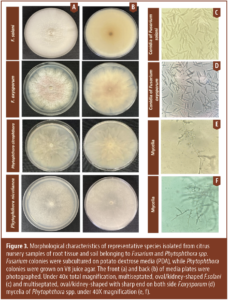
Disease Management Strategies
To effectively manage dry root rot, it is crucial to implement integrated pest management strategies. These may include careful selection of disease-resistant rootstocks, proper irrigation and fertilization practices and the use of fungicides to protect young trees. Additionally, maintaining good orchard sanitation and avoiding excessive soil moisture can help minimize the risk of infection.
Effective management of citrus dry root rot requires a multi-faceted approach. Key strategies include:
1. Disease-free planting material: Sourcing disease-free planting material from reputable nurseries is crucial to prevent the introduction of pathogens into orchards.
2. Soil solarization: Solarizing the soil before planting can help reduce populations of soilborne pathogens, including F. solani.
3. Cultural practices: Proper irrigation, fertilization, and pruning can enhance tree vigor and reduce susceptibility to disease.
4. Chemical control: Fungicide applications can help manage the disease, but it is important to follow label instructions and rotate fungicides to prevent the development of resistant strains.
5. Biological control: The use of beneficial microorganisms, such as Trichoderma spp., can help suppress the growth of F. solani and other pathogens.
By implementing these strategies, citrus growers can mitigate the impact of citrus dry root rot and maintain healthy, productive orchards.











